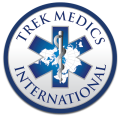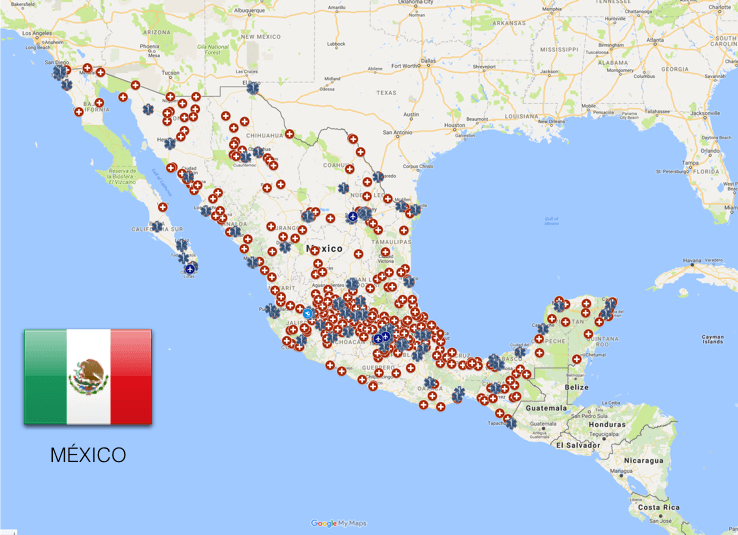AT-A-GLANCE
DIAL 911 TO CALL AN AMBULANCE IN MEXICO
- If that doesn’t work, try 066
- Mexico has an abundance of ambulance services available in most big cities, but quality is difficult to ascertain
- The Mexican Red Cross provides most prehospital emergency care, providing services above and beyond what they are known for in most other countries, but there service is largely restricted to prehospital “911” emergency response
- Inter-facility transfers and medical evacuations are predominately provided by private ground and air ambulance services
HOW CAN I CALL AN AMBULANCE IN MEXICO?
Dial 911 or 066 TO CALL AN AMBULANCE IN MEXICO
Since October 2016, Mexico has been in the process of making 911 the official emergency number for all public emergency services throughout entire country – police, fire, Red Cross and civil defense — transitioning from 066, 089 and over 240 other local numbers. According to the government, 911 is the best number to call, though the other two may still work.
Aside from the national access number, there’s a wide variety of public and private prehospital providers that can be called, depending on the state and/or city you are in:
- Cruz Roja Mexicana (Mexican Red Cross) is the most prominent public prehospital provider with a strong presence throughout much of the country; a full list of their stations organized by State can be found here
Included below are multiple private ambulance services, organized by state. These numbers are for informational purposes only; Trek Medics cannot guarantee that they will remain accurate or operational, nor the quality of care provided.
GROUND AMBULANCE IN MEXICO
BAJA CALIFORNIA
- Ensenada
- Ambulancias IMR: 646-174-0440
- Ambulancia Trasmedic: 646-174-0154
- Dianamed Ambulancias: 646-176-0663
- Rosarito
- Hospital Baja Medix – 661-612-5850
- Tijuana
- Ambulancias Asme Tijuana – 664-681-3237
- Ambulancias Delta 7 – 664-973-0303
- Ambulancias Medix 2000 – 664-608-9690
- AMU Ambulancias – 664-579-6549
- Central Ambulancias – 664-379-3379
- Paramedicos AC – 664-206-8361
- Rescate California AC – 664-166-0855
BAJA CALIFORNIA SUR
- Cabo San Lucas
- Medcare S.A. de C.V.: 624-143-4020
- La Paz
- AmCare: 612-122-5603
- Todos Santos
- Hospital Saint Judes Medical Center: 612-145-0600
CAMPECHE
- Campeche
- Ambulancias Alfa: 981-815-8659
- Ciudad del Carmen
- SASI Servicio de Ambulancias y Seguridad Industrial: 938-166-0792
CHIAPAS
- Tuxtla Gutiérrez
- Healthcare Servicios Integrales de Ambulancias: 961-611-0193
- Ambulancias Línea Médica Vital: 222-320-3716
CHIHUAHUA
- Chihuahua
- Ciudad Cuauhtémoc
- Ambulancias Lider: 625-581-4622
- Sin Fronteras Ambulancias: 625-135-1534
- Ciudad Juárez
- Ambulancias MASH: 656-142-2415
- Ambulancias Médica Plus: 656-616-4505
- Ambulancias SEOF: 656-208-0490
- Grupo SAET: 656-185-6720
CIUDAD DE MÉXICO (D.F.)
- Ambulancias Medicalcare 911: 55-5601-5191
- Ambulancias Rescate Medico: 55-5577-9514
- Ambulancias Sipromedic: 55-5601-7631
- Ambulancias Sumedic: 55-4991-2958
- Ambulancias SURI: 55-4205-9852
- Emergencia Movil (FBM): 55-5715-9052
- Global Medical Team: 55-8590-6764
- Life Support Ambulances: 55-5681-4444
COAHUILA
- Monclavo
- Ambulancia Life Soporte: 866-633-0595
- Saltillo
- Ambulancias Pluscare: 800-890-0925
- Salvage Line Ambulancias: 844-296-5431
- Torreón
- Ambulancias Sagot Laguna: 871-218-1920
- Promedica Empresarial: 871-733-9911
- Villa de Álvarez
- Emergency Care (EC) Ambulancias: 312-157-5362
DURANGO
- Durango
- Alerta Medic Ambulancias Durango (FBM): 618 144 5528
- Ambulancias Emergency Care: 618 170 8962
- Servicio de Apoyo Respiratorio Integral y Servicio de Ambulancias (FBM): 618 837 0912
GUANAJUATO
- Celaya
- Ambulancias Privadas Sepyt: 461 118 1936
- León
- Ambulancias Código 3: 477-761-5858
- Ambulancias Emer León: 477-126-8028 / 477-297-0962
- Ambulancias Enfetem: 473–114-5250
- Ambulancias Life (FBM): 477 770 1012
- Ambulancias Paramedic: 477-190-9575
- Semed Ambulancias: 477-717-6400
JALISCO
- Guadalajara
- Ambulancia Central de Enfermeria y Oxigeno: 33 3615 3868
- Ambulancias EMERJAL: 333-700-8394
- Ambulancias Movil Health: 333-810-2448
- Ambulancias Orión 5: 333-639-1733
- Ambulancias Starmedic: 331-728-3374
- Ambulancias Transmed: 331-212-5996
- Cruz Verde (Green Cross) provides prehospital emergency care and transport in Guadalajara with support from the government
- Puerto Vallarta
- JL Life Ambulancias: 322-128-2516
- Lifeline Ambulance: 322-209-0622
MÉXICO (ESTADO)
- Coacalco
- Medic Life Line: 554-439-5888 / 554-189-2786
- Cuautitlan Izcalli
- Ambulancias Ceros: 55-5871-4183
- Ecatepec
- Advanced Critical Care: 55-4330-1375
- Ambulancias Jet Medical: 55-5120-7287
- ICare Ambulancias: 55-4439-0508
- Naucalpan
- Sistemedic: 55-5360-0661
- Toluca
- Ambulancia Sipromedic: 722-524-07-25
- SUEM: 066 / 722-272-0122
MICHOACÁN
- Morelia
- Ambulancias Ambumed: 443-312-9999
- Asociación Médica de Rescate y Urgencias Médicas (AMRU): 413-316-9032 / 443-198-9743
- Sahuayo
- IVM Ambulancias: 353-532-8504 / 353-125-9000
- Uruapan
- AMRU Ambulancias: (452) 519 08 78
NUEVO LEÓN
- Monterrey
- Ambulancias AM24: 818-123 4070
- Ambulancias Med-Care: 811-594-9197
- Ambulancias Snum: 229-199-3332
- Ambulancias T.U.M. A.C.: 818-355-7243
- Ambulancias Vida: 449-916-0567
- Medica Movil: 818-378-2670
- San Nicolas de los Garza
- Mi Ambulancia: 818-486-5400
- SAMUR Emergencias: 811-872-7170 / 811-927-8656
OAXACA
- Ixtepec
- Ambulancias SUMEA: 971-155-0650
- Oaxaca
- Ambulancias AMSIS: 951-254-7474
- Ambulancias Rottem: 951-514-0925
PUEBLA
- Puebla
- Ambulancias Enlace Vida: 222-750-1858
- Central Uno Ambulancias: 222-750-3790
- Línea Médica Vital: 222-477-6561
QUERÉTARO
- Santiago de Querétaro
- Ambulancias Life Care: 442-214-2548
- Ambulancias Med Care: 442-157-9039
- Ambulancias Medical Health: 442-187-8812
- Medevac EMS: 311-164-6045
QUINTANA ROO
- Cancún
- Ambulancias del Caribe S.A. de C.V.: 998-883-1010
- Playa del Carmen
- Akumal Medical Service: 984-876-2250
SAN LUIS POTOSÍ
- San Luis
- Ambulancias Médica 3: 444-841-6174
- Emphi ABC Ambulancias: 444 813 0813
SINALOA
- Culiacán
- Ambulancias Codigo Rojo: 669-982-1404
- Los Mochis
- Ser-Med Traslados En Ambulancia: 668-817-0081
- Mazatlán
- Ambulancia Codigo Rojo: 669-982-1404
- Ambulancias del Noroeste (FBM): 669-918-1415
SONORA
- Caborca
- TUMn Ambulancias: 637-370-5037
- Ciudad Obregón
- S.M.T. Servicios Medicos de Traslados: 644-174-8165
- Hermosillo
- Ambulancias Delta: 662-260-1260
TABASCO
- Cunudaucán
- Ambulancias GEICER: 914-121-7243
- Comalcalco
- Ambulancias Med Sur Care: 933-152-8856
- Villahermosa
- Ambulancias Olmeca: 993-315-7188
- Ambulancias SPEI: 993-394-9283
TAMAULIPAS
- Matamoros
- C.O.R.A Grupo de Emergencias: 868-819-2881
- Reynosa
- Ambulancias TEMS – Transporte Emergencias Medicas: 899-119-6865 / 899-213-3089
- EmerMedic: 899-142-3736
- MEDix/911: 899-264-0495
- Tampico
- AR Médica: 833-306-2000
- Medcrit Emergencias: 833-217-8484 / 833-217-8431
VERACRUZ
- Perote
- Servicios Profesionales De Atencion Prehospitalaria De Perote A. C.: 282-825-3968
- Xalapa
- Cruz Ambar: 228-817-7055
C5 (el Centro de Comando, Control, Cómputo, Comunicaciones y Contacto Ciudadano de la Ciudad de México) located in Mexico City is in charge of national emergency communications (C4 –
There are multiple EMS providers nationwide with trained responders of varying degrees from unskilled ambulance attendants to advanced care paramedics. The level of education and training varies between providers
- Technicos en Urgencias Medicas (TUM – Emergency Medical Technicians) 300 – 600 hours
- Many receive “virtually no training, especially among the wide range of volunteers who supplement the pre-hospital care system” (Garcia-Rosas, 442)
- Mexico City (Peralta, 107)
- Multiple institutions offer EMS training in Mexico City (similar across country)
- Red Cross
- Amber Cross
- Nationaly Polytechnic Institute
- National Autonamous University of Mexico
- Many others
- Basic-level training curricula tends to be similar in scope and format
- However, programs are often registered with different gov’t agencies
- Voluntary EMT registry recently created by Federal District Ministry of Health (Mexico City)
- Three recognized levels of EMS training/care
- Basic
- Intermediate
- Advanced
- Subsequent evaluation process (written and practical)
- 50.9% passed Basic; no data from remaining levels
- Three recognized levels of EMS training/care
- Multiple institutions offer EMS training in Mexico City (similar across country)
- Monterrey, San Pedro, Santa Catarina (Arreola-Risa – Prehosp Disaster Med)
- “In each case, half or more of the personnel only had on-the-job training consisting of skills and knowledge they learned from colleagues during their daily work without any formal education and training courses.”
- EMT Certification
- Monterrey: 50%
- San Pedro: 30%
- Santa Catarina: 20%
- “At baseline, virtually none of the personnel had any type of trauma-related, in-service training, such as participation in [PHTLS] or [BTLS]”
- All services comprised of approx. 50% paid staff and 50% volunteers
- Educational levels impact ability of students to understand/utilize future training
- EMT Certification
- “In each case, half or more of the personnel only had on-the-job training consisting of skills and knowledge they learned from colleagues during their daily work without any formal education and training courses.”
Conventional ambulances are commonly found across Mexico. However, taxis are also used when deemed to be faster – if the locals encourage you to take a taxi, you should listen to them. In places where congestion is gridlocked (like Mexico City) or in rural areas where coverage is minimal, it may be wiser to take the nearest taxi.
Air medical evacuation is also available in the most popular tourist destinations, as well as in the biggest cities, though pickups at most of the far-flung airstrips across Mexico are also possible — U.S. and Mexican medical evacuation providers are familiar with most of them. Check out our Mexico EMS Coverage Map for a full list of publicly promoted air medical evacuation providers
FOR MEXICAN CITIZENS
- Several sources for population’s health care financing
- 60% – Social Security Medical Services – 60%
- Provided by gov’t programs: IMSS and ISSSTE
- 20% (approx.) – Federal Secretary of Health
- 10% (approx.) – Private physicians/hospitals
- 10% (approx.) – Unfunded except for care at indigent hospitals
- 60% – Social Security Medical Services – 60%
- EMS
- The Red Cross raises money through public donations
- Private ambulance providers are paid through subscriptions, premiums and/or out-of-pocket charges
ADDITIONAL INFO
Common Emergencies in Mexico
- Earthquakes are common, with the most recent having occurred in the state of Chiapas on Sept. 7th, 2017 (Magnitude 8.1), and a 7. magnitude referred to as the Central Mexico Earthquake on Sept. 19th, 2017. Owing to the historic 1985 Mexico City earthquake which killed thousands, Mexico has since made earthquake preparedness a regular part of civil society.
- Tsunamis
- Interpersonal violence, owing to drug cartel activities
Vaccinations for Mexico
According to the US Centers for Disease Control and Prevention (CDC), different groups of travelers will require different vaccinations for travel in Mexico:
- All Travelers:
- Measles-mumps-rubella (MMR) vaccine
- Diphtheria-tetanus-pertussis vaccine
- Varicella (chickenpox) vaccine
- Polio vaccine
- Your yearly flu shot
- Zika is also a risk in Mexico. Read the CDC’s Zika Travel Notice for Mexico
- Most Travelers:
- Hepatitis A
- Typhoid
- Some Travelers:
- Hepatitis B
- Malaria
- Rabies
Read more about travel in Mexico at the CDC website: https://wwwnc.cdc.gov/travel/destinations/traveler/none/mexico/ (Last accessed: Sept. 20, 2017)
Emergency Medicine as a Specialty in Mexico
- 1986 – First EM residency at General Hospital of Balbuena, Mexico City
- 1991 – rapid expansion of trained EM MDs begins when Mexican Institute of Social Services (IMSS) initiates “a network of Emergency Medicine residencies, accepting 150 residents per year throughout México into 3-year programs” (Garcia-Rosas, 442)
- 2004 – 14 Emergency Medicine residency programs in México (Garcia-Rosas, 443)
EMS Development in Mexico City (Peralta, 104-5)
- “Emergency medical services in Mexico City were developed without clinical or administrative standards and without proper planning” (Peralta, 105)
- No regulation, standardized medical protocols, or medical guidance
- Official Mexican Norm (NOM) – attempt by Health Secretariat to regulate activity of EMS providers in Mexico City
- Established conditions under which agencies must provide care, including air and ground transport.
- Norm does not implement specific requirements for:
- Providers’ qualifications
- Pt care documentation
- Education
- Financing
- Medical Control
- Other key system components
- Scope of training/Field Practices delegated to EMS providers, allowing them to establish own criteria for care based on selected standards
- Limits accountability for government and providers
- Norm clearly addresses:
- Specific training
- Educational requirements
- Regulating Centers
- Role of Medical Direction
- Operative requirements for services
- Remains vague and imprecise in other areas, including:
- Medications that can be administered
- Personnel qualifications
- Service regulation
- Does not address key performance indicators or administrative requirements
- Lack of data on evaluation and/or transportation of Pt’s in Mexico City
- Researchers cannot study conditions in which Pt’s were transported/treated, and then relate data to Pt outcomes/In-hospital evaluation
- “Much controversy still exists regarding the true benefits of advanced versus basic levels of care” (Peralta, 105).
911 Emergencias is the official government agency overseeing public emergency response providers.
The most recent published statistics from the public 911 system can be found here.
- Arreola-Risa C, Mock C, Herrera-Escamilla AJ, Contreras I, Vargas J: “Cost-effectiveness and benefit of alternatives to improve training for prehospital trauma care in mexico.” Prehospital and Disaster Medicine 2004;19(4):318-25.
- Arreola-Risa C, Mock CN, Lojero-Wheatly L, de la Cruz O, Garcia C, Canavati-Ayub F, Jurkovich GJ: “Low-cost improvements in prehospital trauma care in a Latin American city.” The Journal of Trauma: Injury, Infection, and Critical Care 2000;48(1):119-24.
- Garcia-Rosas C, Iserson KV: “Emergency Medicine in México.” The Journal of Emergency Medicine 2006;31(4):441-5.
- Peralta LM “The Prehospital Emergency Care System in Mexico City: A System Performance Evaluation.” Prehospital and Disaster Medicine 2006;21:104-11.
- “Número 911 para emergencias ya en todo México” (debate.com.mx)
- “El fracaso del 066 y el nuevo 911” (AnimalPolitico.com)
SCOREBOARD
% of Seriously Injured Transported by Ambulance in Mexico
[Source: 2013 Global Status Report on Road Safety, WHO]
ROAD TRAFFIC INJURY DEATHS
(PER 100,000 POPULATION)
[Source: 2015 Global Status Report on Road Safety, WHO]
REPORTED HOMICIDES
(PER 100,000 POPULATION)
[Source: 2014 Global Status Report on Violence Prevention, WHO-UNDP]




